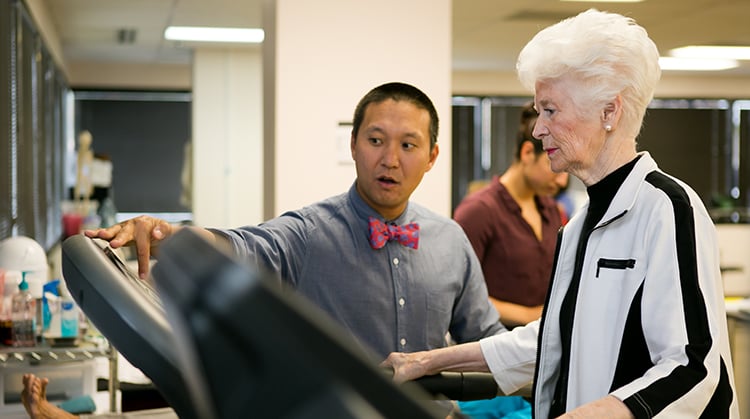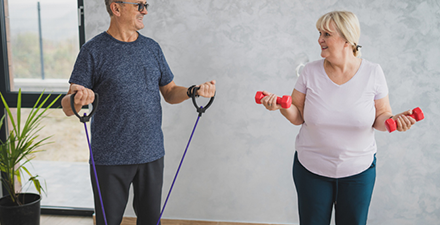Physical Therapy Guide to Osteopenia (Low Bone Mass)
Osteopenia is a term used to describe lower-than-normal bone density or thickness. Osteopenia (or low bone mass) is often confused with osteoporosis, a condition involving more severe bone loss. Approximately 54 million U.S. adults aged 50 years or older have osteoporosis. But 34 million people in the U.S. have osteopenia, which can occur at any age.
A diagnosis of osteopenia presents an opportunity for you to take better care of your bone health. Physical therapists offer guidance for exercises and lifestyle changes that can help improve your muscle and bone strength.
Physical therapists are movement experts. They improve quality of life through hands-on care, patient education, and prescribed movement. You can contact a physical therapist directly for an evaluation. To find a physical therapist in your area, visit Find a PT.
What Is Osteopenia (Low Bone Mass)?
Low bone mass is a condition that develops when a person:
- Has naturally lower bone density due to factors such as body size, genetics, or gender.
- Has gradually lost bone mass over time due to lack of exercise and poor diet.
- Begins to transition into menopause, when a loss of 20% to 30% of bone density naturally occurs.
- Has rapidly lost bone mass due to an illness or use of medication.
How Does It Feel?
Generally, no symptoms occur with low bone mass. However, there are some subtle signs, called red flags that can indicate bone loss. Among them:
- A loss of more than 1.5 inches of height. This loss may indicate that your spinal bones are collapsing.
- A rounded upper back (kyphosis), which pushes your head forward. This may indicate that the spinal bones (vertebrae) are changing shape due to bone loss.
- Breaking a bone with very little impact. If you break a bone easily, such as falling from a standing height, you may have bone loss.
- Deep thigh pain in the middle section of your thigh bone. If you experience this type of pain, notify your doctor immediately. You may be at risk for a spontaneous thigh fracture, especially if you have been taking a fracture prevention medication.
You may simply not know that you have osteopenia. It is important to recognize any risk factors you may have. Your health care provider and physical therapist can help identify them.
How Is It Diagnosed?
Low bone mass is diagnosed through a quick and painless specialized scan ordered by a physician. If you are seeing a physical therapist for rehabilitation, they may confer with your physician if they detect a possible need for bone testing.
The results of the scan are reported using T- and Z-scores.
The T-score compares your score with that of healthy 30-year-old women. A T-score between -1 and -2.49 means that you have low bone mass or osteopenia. Those who have a T-score of -2.5 and lower have osteoporosis.
Other methods of screening bone density include X-ray, ultrasound, and CT scan. If you have risk factors that include certain diseases, short- or long-term use of steroids, or a recent bone fracture, a DXA scan also may be prescribed. Your physical therapist can help determine what tests are best for you.
How Can a Physical Therapist Help?

A physical therapist can help you prevent and treat low bone mass at any age. They will prescribe the specific amount and type of exercise that best builds and maintains strong bones.
Your physical therapist will review your health history, including your medical, family, medication, exercise, dietary, and hormonal history. They will also conduct a complete physical examination and identify your risk factors for low bone density.
It is important to exercise throughout life. It is especially important to exercise to maintain healthy bones if you have been diagnosed with low bone mass. Exercise can help to build bone or slow the loss of bone mass.
Your physical therapist is likely to prescribe exercise and physical activity to help prevent fractures and falls, and to reduce bone loss. Your treatment program may include:
Exercise focus
- Posture guidance (spinal alignment and awareness for fracture prevention).
- Balance training.
- Leg strengthening.
- Spine stretches.
- Hip stretches.
Weight-bearing exercises
- Dancing.
- Tai chi.
- Walking at a quick pace (122-160 steps per minute, or 2.6 steps per second).
- Jumping, stomping, heel drops.
- Running.
- Racket sports.
Resistance exercises
- Weightlifting.
- Use of resistance bands.
- Gravity-resistance exercises (such as pushups, stair climbing).
Caution: Yoga and Pilates contain movements that may increase fracture risk for people with osteopenia or osteoporosis. If you have low bone density, it is important to avoid any movements that round or twist the spine and put excessive force upon the vertebrae.
Your physical therapist will design a personalized exercise program for you based on your needs and goals. They will also consider other physical issues that you may have. Treatment starts at the level you can tolerate. Once you learn how to perform your program, your physical therapist may add other activities. This increased physical effort will encourage your bones to grow stronger.
Your treatment plan may include exercises for the hips, spine, shoulders, and wrists. Your physical therapist will design a specific program based on the intensity, frequency, and amount of exercise that is best for you.
Exercise is only one component of healthy bones. Your physical therapist will encourage you to pursue a healthy and varied diet. They may suggest that you see a dietitian, who can teach you about the many foods that contribute to bone health. Your doctor also may prescribe medication or hormone replacement therapy. Your health care team will help you find the best combination of exercise, diet, and medicine to treat your condition.
Can This Injury or Condition Be Prevented?
You can reduce your chances of developing low bone mass by avoiding these risk factors:
- Cigarette smoking.
- Excessive alcohol intake (greater than one drink per day for women, two per day for men).
- Poor diet.
- Low calcium and vitamin D levels.
- A low activity level – less than 5,000 steps per day.
What Kind of Physical Therapist Do I Need?
All physical therapists are prepared through education and experience to treat low bone mass. However, you may want to consider:
- A physical therapist who is a board-certified clinical specialist in women’s health, geriatric, or orthopedic physical therapy. This physical therapist has advanced knowledge, experience, and skills that may apply to your condition.
- A physical therapist who is experienced in treating people with women’s health, geriatric, or orthopedic conditions. Some physical therapists have a practice with a focus on women’s health, geriatrics, orthopedics, and osteopenia/osteoporosis.
You can find physical therapists who have these and other credentials by using Find a PT, the online tool built by the American Physical Therapy Association to help you search for physical therapists with specific clinical expertise in your geographic area.
General tips when you're looking for a physical therapist (or any other health care provider):
- Get recommendations from family and friends or from other health care providers.
- When you contact a physical therapy clinic for an appointment, ask about the physical therapists' experience in helping people who have osteopenia or osteoporosis.
- Be prepared to share your desired activities and goals and describe the activities that you have trouble doing.
The American Physical Therapy Association believes that consumers should have access to information that could help them make health care decisions, and also prepare them for a visit with their health care provider.
The following articles provide some of the best scientific evidence related to physical therapy treatment of low bone mass. The articles report recent research and give an overview of the standards of practice both in the U.S. and internationally. The article titles are linked either to a PubMed* abstract of the article or to free full text, so that you can read it or print out a copy to bring with you to your health care provider.
US Department of Health and Human Services, National Institutes of Health. Bone mineral density in childhood study (BMDCS). Reviewed June 18, 2019. Accessed January 22, 2020.
Sahin K, Ergin ON, Bayram S, Akgul T. Atypical femoral fractures related to bisphosphonate use: A comprehensive review of 19 patients. Ulus Travma Acil Cerrahi Derg. 2019;25(6):603-610. Article Summary in PubMed.
Giangregorio LM, McGill S, Wark JD, et al. Too fit to fracture: outcomes of a Delphi consensus process on physical activity and exercise recommendations for adults with osteoporosis with or without vertebral fractures. Osteoporos Int. 2015;26(3):891-910. Article Summary in PubMed.
Chahal J, Lee R, Luo J. Loading dose of physical activity is related to muscle strength and bone density in middle-aged women. Bone. 2014;67:41-45. Article Summary in PubMed.
Hackney ME, Wolf SL. Impact of Tai Chi Chu'an practice on balance and mobility in older adults: an integrative review of 20 years of research. J Geriatr Phys Ther. 2014;37(3):127-135. Article Summary in PubMed.
Rowlands A, Schuna JM Jr, Stiles VH, Tudor-Locke C. Cadence, peak vertical acceleration and peak loading rate during ambulatory activities: implications for activity prescription for bone health. J Phys Act Health. 2014;11(7):1291-1294. Article Summary in PubMed .
Cosman F, de Beur SJ, LeBoff MS, et al. Clinician’s guide to prevention and treatment of osteoporosis [correction published in Osteoporos Int. 2015]. Osteoporos Int. 2014;25(10):2359-2381. Article Summary in PubMed.
Sinak M. Yoga spinal flexion positions and vertebral compression fracture in osteopenia or osteoporosis of spine: case series. Pain Pract. 2013;13(1):68-75. Article Summary in PubMed.
Saraví FD, Sayegh F. Bone mineral density and body composition of adult premenopausal women with three levels of physical activity. J Osteoporos. 2013;2013:953271. Article Summary in PubMed.
Bielemann RM, Martinez-Mesa J, Gigante DP. Physical activity during life course and bone mass: a systematic review of methods and findings from cohort studies with young adults. BMC Musculoskelet Disord. 2013;14:77. Article Summary in PubMed.
Gomez-Cabello A, Ara I, Gonzalez-Aguero A, Casajus JA, Vicente-Rodriguez G. Effects of training on bone mass in older adults: a systematic review. Sports Med. 2012;42(4):301-325. Article Summary in PubMed.
Going SB, Farr JN. Exercise and bone macro-architecture: is childhood a window of opportunity for osteoporosis prevention? Int J Body Compos Res. 2010;8:1-9. Article Summary in PubMed.
Martyn-St James M, Carroll S. Meta-analysis of walking for preservation of bone mineral density in postmenopausal women. Bone. 2008;43(3):521-531. Article Summary in PubMed.
Magkos F, Kavouras SA, Yannakoulia M, Karipidou M, Sidossi S, Sidossis LS. The bone response to non-weight-bearing exercise is sport-, site-, and sex-specific. Clin J Sport Med. 2007;17(2):123-128. Article Summary in PubMed.
Siminoski K, Warshawski RS, Jen H, Lee K. The accuracy of historical height loss for the detection of vertebral fractures in postmenopausal women. Osteoporos Int. 2006;17(2):290-296. Article Summary in PubMed.
Winters-Stone KM, Snow CM. Site-specific response of bone to exercise in premenopausal women. Bone. 2006;39(6):1203-1209. Article Summary in PubMed .
*PubMed is a free online resource developed by the National Center for Biotechnology Information (NCBI). PubMed contains millions of citations to biomedical literature, including citations in the National Library of Medicine's MEDLINE database.
Expert Review:
Jan 11, 2020
Revised:
Jan 11, 2020
Content Type: Guide
Osteopenia
PT, DScPT, MHS
Sherri R. Betz
PT, DPT, certified exercise expert for aging adults and board-certified clinical specialist in geriatric physical therapy, on behalf of the Bone Health Special Interest Group of the Academy of Geriatric Physical Therapy
You Might Also Like...
Health Tips
From Pregnancy to Menopause: 4 Ways Physical Therapy Advances Women’s HealthApr 15, 2024
Physical therapy isn't only for rehabilitation from sports injuries or recovering after surgery? Physical therapists also play an important role in women's
Health Tips
Bone Health: What You Should KnowJan 15, 2019
For healthy bones, it is important to maintain a physically active lifestyle and eat a balanced diet. Physical therapists can design a unique program for
Health Tips
9 Things Your Physical Therapist Wants You To Know About Aging WellSep 28, 2018
With the right type and amount of physical activity, we can help stave off many age-related health problems. These nine tips from physical therapists will


